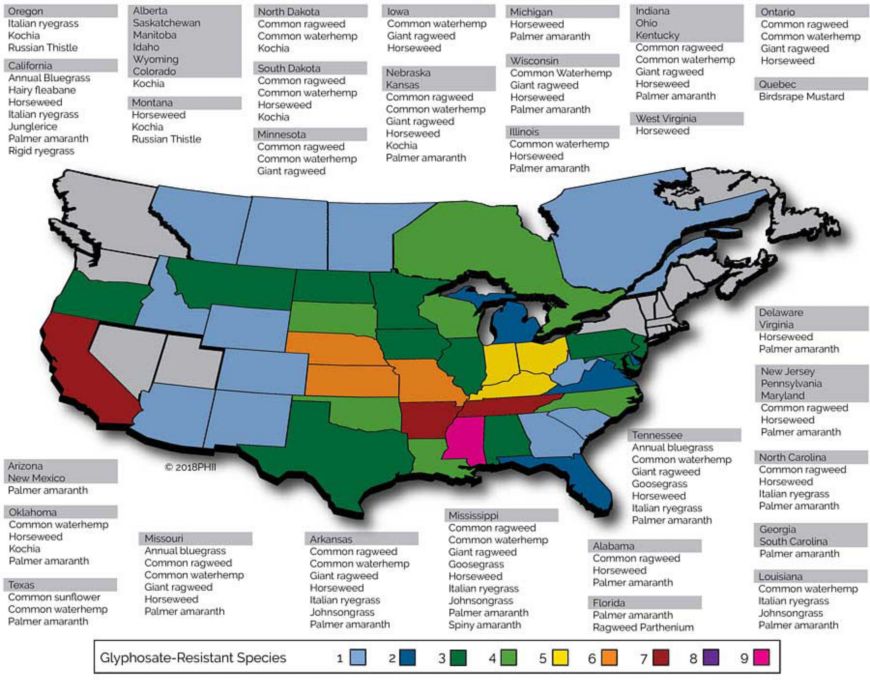History and Current Status
- Glyphosate was introduced in the U.S. in 1976.
- The first case of evolved resistance to glyphosate was confirmed in rigid ryegrass in Australia in 1996.
- The first case of glyphosate resistance in the U.S. occurred in 2000 in horseweed (marestail) in Delaware.
- To date, glyphosate resistance has been confirmed in 41 weed species worldwide, including 18 in North America.
- Glyphosate resistant weed populations have been confirmed in 38 states and 5 provinces (Figure 1).
Figure 1. Confirmed cases of glyphosate resistance in North America as of spring 2018.

How Do Weeds Become Herbicide Resistant?
- Herbicide resistance is the inherited ability of a plant to survive and reproduce following exposure to a dose of herbicide normally lethal to the wild type.
- Herbicides do not induce resistance in weed species, rather they simply select for resistant individuals that naturally occur within the weed population.
- Once a resistant plant has been selected, repeated use of a herbicide over multiple generations allows resistant plants to proliferate as susceptible plants are eliminated.
Herbicide Failure Can Be Rapid
- Weed resistance to continuous use of the same herbicide occurs on a logarithmic rate of seed increase.
- The percentage of weeds in the population that are resistant to the herbicide gradually increases at an imperceptible rate and then makes a logarithmic jump to become more than half the weed population.
- This is why fields typically go from adequate control (>90% control) to failure (<50% control) in one year (Table 1).
Table 1. Logarithmic progression of resistance to herbicides¹.


Factors Influencing Resistance Risk
- Most factors that influence the risk of herbicide resistance are inherent characteristics of a weed species and cannot be affected by management.
- Mutation rate for resistance traits
- Number of genes required to confer resistance
- Dominance of the resistance allele
- Inheritance of resistance traits
- Fitness of resistant plants
- The only risk factor that growers can change is herbicide selection intensity.
- Herbicide selection intensity is determined by herbicide efficacy, persistence, and frequency of application.
- Combination or rotation of herbicide modes of action can reduce selection intensity.
- Agronomic practices such as crop rotation and tillage can decrease herbicide selection intensity by reducing weed populations.
Weed Species Vary Widely in Resistance Risk
- Many weed species that have developed resistance to glyphosate already had extensive histories of resistance to other herbicides, indicating that they have an inherently high risk for resistance development.
- Multiple resistance is becoming an increasing problem in species such as waterhemp, where resistance to alternative herbicides is already common.
- Some of the worst glyphosate-resistant weeds are also highly prolific seed producers, making them exceptionally capable of spreading resistance once it occurs.

Considerations for Resistance Management
Reduce the development of glyphosate resistance
- Practices that reduce glyphosate selection intensity such as combination or rotation of herbicides, crop rotation, or tillage can reduce the risk of resistance.
- A sequential weed management program can reduce selection intensity by using multiple herbicide modes of action as well as provide more consistent weed management.
Reduce the spread of glyphosate resistance
- Movement by field equipment appears to be a major factor in the spread of glyphosate resistant weeds.
- Cleaning tillage and harvest equipment when moving between fields can reduce the movement of weed seeds and slow the spread of resistant populations.
Practice good stewardship of all weed management technologies
- Weed management systems using crops resistant to other herbicide modes of action such as glufosinate, HPPD inhibitors, and synthetic auxins (2,4-D and dicamba) offer additional tools to manage glyphosate-resistant weeds.
- However, weed populations resistant to each of these modes of action already exist in North America.
- Overreliance on any single herbicide to manage glyphosate-resistant weeds can lead to resistance to that herbicide as well.
Heap, I. The International Survey of Herbicide Resistant Weeds. Online. Internet. May 14, 2018. Available www.weedscience.com
Authors: Mark Jeschke and Samantha Teten
May 2018
The foregoing is provided for informational use only. Please contact your Pioneer sales professional for information and suggestions specific to your operation. Product performance is variable and depends on many factors such as moisture and heat stress, soil type, management practices and environmental stress as well as disease and pest pressures. Individual results may vary.